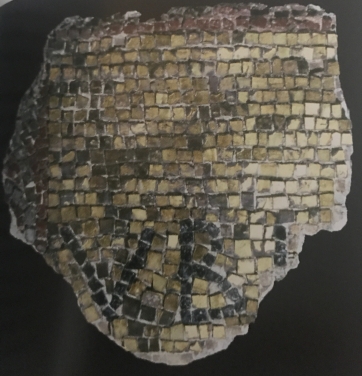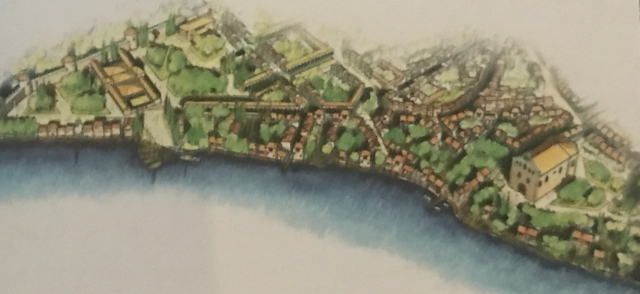Overall Impact: – 0 stars – very little to see!
Access * 1 star – easy access to Museum, other areas difficult to find
Atmosphere * 1 star – you need to use your imagination to visualise Visigoths
Other *** 3 stars – fascinating subject, but seemingly little local interest
Brief Historical Background
The Visigoths under Alaric sacked Rome in 410, seizing portable treasures. Even Galla Placidia – the sister of Honorius, the Western Augustus – was captured. On Alaric’s death his brother Athaulf succeeded him as leader and spent the years 410 to 415 operating in the Gallic and Spanish provinces, playing competing factions of Germanic and Roman commanders off against each another. He captured Toulouse in 413 and married Galla Placidia in 414 as the Western Imperial Government started to come to terms with the Goths as useful allies. Honorius’ regime used Athaulf to provide Visigothic assistance in regaining nominal Roman control of Hispania from the Vandals, Alans and Suevi.
In 418, Honorius’ regime rewarded his Visigothic allies, now under King Wallia, by giving them land in Gallia Aquitania along the Garonne Valley with Tolosa (Toulouse) as their capital. This is thought legally to have been achieved through hospitalitas – the rules for the billeting of soldiers. At first the Visigoths were not given a large extent of landed estates in Aquitania but they did gain the right to the taxes of the region, so that the Gallic aristocrats, farmers and traders now paid their taxes to the Visigoths instead of to the Western Roman Government.
Settling a barbarian group effectively as a ‘state within a state’ within the boundary of the Empire was a novel and desperate measure, but it was a settlement which the Honorian regime – holed up within the walls of Ravenna, behind protecting marshes – grasped with some relief after Alaric’s sack of Rome in 410 and the chaos of the previous years.
Furthermore the Visigoths, like other barbarian tribes, were Arian Christians having been converted in the mid-Fourth Century when the Arian doctrine of the Trinity was the ‘orthodoxy’ of the Church and Emperor. Arianism is the belief that Jesus Christ is the Son of God, who was begotten by God the Father at a point in time, and is therefore distinct from God the Father and therefore subordinate to the Father. The Emperor Constantine at the Council of Nicaea in 325, and Theodosius at the Council of Constantinople in 381, had strengthened the Nicene formula of the co-essential divinity of the Son, applying to Jesus Christ the term “consubstantial”. The 381 version speaks of the Holy Spirit as worshipped and glorified with the Father and the Son. Thus Arians became heretics in the sight of the Empire.
The Visigothic Kingdom continued in Spain, but not in Toulouse, until the Muslim invasion of 711. Clovis welded together the Frankish Kingdom in the early Sixth Century, and in 507, with Burgundian assistance, he defeated the Visigothic King Alaric II at the Battle of Vouillé (Campus Vogladensis) near Poitiers and went on to capture Aquitania and sack Toulouse. By 508 the Visigoths had lost their their grip on Aquitania and only retained the coastal strip called Septimania stretching from Narbonne and Nîmes.
Tolosa was the Visigothic capital for nearly a century – so can we find the remains of their regime?
They are very hard to find. We spent a few days haunting the museums and sites of Toulouse and there are not many traces and very little published information. What remains is generally described as ‘late antique’ rather than Visigothic, and there are few explicit references to the Visigothic period.
This post is about what we found.

Health Warnings
Two ‘health warnings’, though, are needed: first, it is not unreasonable to talk about ‘late antiquity’ since any existing buildings of Tolosa would, as part of the Empire, have been made use of by the new Visigothic rulers of the City after 413. Furthermore, it is difficult to distinguish between the Orthodox (Nicene) churches and sarcophagi of the Fifth Century from the Arian ones of the Visigoths.
Secondly, because Alaric is thought in 410 to have carried off from Rome Titus’s booty from the Sack of the Jerusalem Temple, including the Menorah (the seven-branched candelabra), and because in the 13th Century Toulouse went on to become the centre of the Cathars and the Albigensian Crusade, one’s investigations can quickly stray into the misty world of pseudo-history and fictional conspiracy theory. What follows in this blog does not touch on the fate of the Ark of the Covenant, the Priory of Sion – or the novels of Dan Brown!
Sarcophagi in the Musée Saint Raymond
In the museum basement there is a fine collection of late antique sarcophagi from across south-west France. The intriguing question is: are they from the Visigothic period, and are they Orthodox (Nicene) or Arian – and how would you tell?

The Daurade Church
One of the most tragic losses is the Daurade or ‘golden’ Church. It seems likely that this was the Arian Church, close to the Visigothic Palace. The church consisted of nave based on the classical Roman Temple of Apollo, a probably Fifth Century apse, and later additions. It was demolished for a grand but conventional French classical church of 1761. Frustratingly, we are left just with drawings of the impressive apse made before its destruction. One can only think, for a parallel, of the mosaics at San Appolinare Nuovo in Ravenna.

The demolition of a classical Temple with late antique mosaics puts one in mind of Charles V’s comment when he learned that the stunning mosque at Córdoba had had a standard C16th church inserted at its core. He reputedly said: “You have built here what you or anyone might have built anywhere else, but you have destroyed what was unique in the world.”

All that survives are the late antique columns that were given away after the demolition in the C18th and a small fragment of mosaic with gold tesserae.

The Visigothic Palace
This was discovered in 1989 adjoining the Roman city walls on the bank of the River Garonne, near the site of the NW gate of the Roman City. Although the site was excavated and photographed, there seems to have been no detailed recording made of this unique site and the ruins were not preserved. An undistinguished development of 1990s apartments is no substitute.
Saint Pierre-des-Cuisines
This Church just outside the Roman Walls opposite the Palace and near the Garonne dates from the C5th and was built around a necropolis. Its core is early and would date to the Visigothic period.
Wall in Jardin des Plantes
There is also a small surviving section of late antique wall in the south of the city in the Jardin des Plantes

Toulouse under the Visigoths
Under the Visigoths, Toulouse appears to have prospered more than cities that remained at that time under imperial Roman rule. Given the dominance of the Garonne Valley down to Bordeaux, and the conquest of Hispania and the Gallic Mediterranean sea-board, Tolosa – unlike many late antique cities – appears to have maintained its population levels. It was the centre of an expansionist, although barbarian, Arian kingdom, one which was dedicated to preserving the civilisation that had laid the golden eggs.







